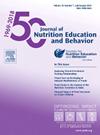Cultivating Connections - Community, Family, and Farmer Engagement in Food Education: Strategies and Benefits and Food of Education Across Stakeholders
IF 2.3
3区 医学
Q2 EDUCATION, SCIENTIFIC DISCIPLINES
引用次数: 0
Abstract
Objective
A collaboration with food system stakeholders delivered food education in ECE settings to increase familiarity with fruits and vegetables, provide markets for farmers, and engage teachers/parents in food education.
Use of Theory or Research
Social Cognitive Theory
Target Audience
Pre-schoolers, caregivers, culinary students
Program Description
Monthly produce tastings and in-class food education was offered in collaboration with stakeholders. Local farms supplied seasonal produce. High school culinary students prepared and packaged samples. WSU Extension facilitated delivery of harvest samples and provided nutrition education.Teachers distributed the samples during snack/circle time and incorporated nutrition and fresh food education into learning the environment. Parents received monthly Harvest Recipe Sheets.
Evaluation Methods
Evaluation data was collected through responses to Knowledge, Attitude, and Practice survey questions collected on paper, online, and observation.
Results
An increase in familiarity with the fruit and vegetable was reported by 38% of the culinary students, and 17% adopted a new behavior, reporting purchasing at least one of the featured produce prepare at home.Parents reported preparing the recipe at home, purchasing a featured fruit or vegetable, tried one at least one of the Kids in the Kitchen activity described on the Harvest Sheet, and changed how they stored produce after reading the “how to store” section of the harvest sheet. Farmers reported that the small earnings, when added to other revenue streams, contributed to their over-all earnings for the year.
Conclusions
Farm to early care and education programs encourage activities and strategies to promote health and wellness and enhances the overall quality of the educational experience. This project reflects the value of collaboration with food system partners to offer an inclusive and comprehensive fresh food education program. Monthly tastings of fresh, minimally processed fruits and vegetables resulted in increased familiarity of local, seasonal produce with early learners and their teachers and parents, as well as culinary students who prepared the samples.
Funding
USDA – National Institute of Food and Agriculture
培养联系——社区、家庭和农民参与食品教育:跨利益相关者的战略和利益以及食品教育
与食品系统利益相关者合作,在欧洲经委会环境中提供食品教育,以提高对水果和蔬菜的熟悉程度,为农民提供市场,并使教师/家长参与食品教育。理论或研究的使用社会认知理论目标受众学龄前儿童、看护者、烹饪专业学生项目描述与利益相关者合作,每月提供农产品品尝和课堂食物教育。当地农场供应时令农产品。高中烹饪学生准备和包装样品。WSU推广促进了收获样品的交付,并提供了营养教育。教师在点心/圈时间分发样本,并将营养和新鲜食品教育纳入环境学习。家长们每月都会收到“收获食谱”。评估方法通过对知识、态度和实践调查问题的回答,通过书面、在线和观察收集评估数据。结果38%的烹饪专业学生对水果和蔬菜的熟悉程度有所提高,17%的学生采用了一种新的行为,他们报告至少购买了一种特色农产品在家准备。家长们报告说,他们在家准备食谱,购买特色水果或蔬菜,尝试至少一项收获单上描述的“孩子在厨房”活动,并在阅读了收获单上的“如何储存”部分后改变了他们储存农产品的方式。农民们报告说,这些微薄的收入加上其他收入来源,为他们全年的总收入做出了贡献。结论farm to early care and education项目鼓励促进健康和健康的活动和策略,并提高教育体验的整体质量。该项目反映了与食品系统合作伙伴合作提供包容和全面的新鲜食品教育计划的价值。每月品尝新鲜的、最低限度加工的水果和蔬菜,使早期学习者、他们的老师和家长以及准备样品的烹饪学生对当地季节性农产品更加熟悉。资助美国农业部-国家粮食和农业研究所
本文章由计算机程序翻译,如有差异,请以英文原文为准。
求助全文
约1分钟内获得全文
求助全文
来源期刊
CiteScore
4.20
自引率
11.50%
发文量
379
审稿时长
44 days
期刊介绍:
The Journal of Nutrition Education and Behavior (JNEB), the official journal of the Society for Nutrition Education and Behavior, is a refereed, scientific periodical that serves as a global resource for all professionals with an interest in nutrition education; nutrition and physical activity behavior theories and intervention outcomes; complementary and alternative medicine related to nutrition behaviors; food environment; food, nutrition, and physical activity communication strategies including technology; nutrition-related economics; food safety education; and scholarship of learning related to these areas.
The purpose of JNEB is to document and disseminate original research and emerging issues and practices relevant to these areas worldwide. The Journal of Nutrition Education and Behavior welcomes evidence-based manuscripts that provide new insights and useful findings related to nutrition education research, practice and policy. The content areas of JNEB reflect the diverse interests in nutrition and physical activity related to public health, nutritional sciences, education, behavioral economics, family and consumer sciences, and eHealth, including the interests of community-based nutrition-practitioners. As the Society''s official journal, JNEB also includes policy statements, issue perspectives, position papers, and member communications.

 求助内容:
求助内容: 应助结果提醒方式:
应助结果提醒方式:


